Occupational environment monitoring of a fertilizer manufacturing factory
99,000 ₫
Note: The above price is calculated for one sample, and the price may fluctuate depending on the area of the environment to be monitored and market movements. For more accurate pricing support, please refer to the price list or contact our consulting staff directly.
Monitoring the environment of a fertilizer manufacturing factory is a session of collecting, analyzing, and evaluating factors at the workplace that may harm workers health.
Table of Contents
Toggle1. Overview of the fertilizer manufacturing factory
a. What is a fertilizer manufacturing factory?
Factory manufacturing fertilizer is a manufacturing facility specializing in producing fertilizers for agriculture and crops. Fertilizer is a type of nutrient used to provide essential nutrients for crops and help increase yield and quality of agricultural products.
A fertilizer manufacturing factory can produce organic fertilizers or chemical fertilizers. Organic fertilizers are manufactured from natural materials such as animal manure, plant compost, and other organic matter. Meanwhile, chemical fertilizers are manufactured from chemicals such as ammonia, sodium nitrate, and potassium nitrate.
The fertilizer manufacturing process includes many stages such as material selection, decomposition, drying, mixing, and packaging. Fertilizer manufacturing factories can produce different types of fertilizers to meet market demand and specific requirements of various crops.

b. Manufacturing stages in a fertilizer manufacturing factory
The fertilizer manufacturing process in the factory can be divided into the following main stages:
- Material selection: Materials used for fertilizer manufacturing include animal manure, plant compost, organic matter, and chemical compounds such as ammonia, potassium nitrate, and sodium nitrate. These materials are selected based on the characteristics of the crops requiring fertilizer.
- Decomposition: At this stage, materials are processed to decompose into nutrients such as nitrogen, phosphorus, potassium, and other organic substances. Decomposition techniques may include the use of bacteria, fungi, or chemical methods.
- Drying: After decomposition, nutrients are dried to remove water and bring them to the necessary moisture level for the next production stage.
- Mixing: Nutrients are mixed together to create the required types of fertilizers for crops. Fertilizer types may include NPK (nitrogen, phosphorus, potassium), fertilizers containing a specific nutrient, or organic fertilizers.
- Packaging: After mixing, fertilizers are packaged into bags for convenient transportation and storage.
- Quality inspection: Before being put on the market, fertilizer samples are tested to ensure they meet the standards and specific requirements of agriculture and crops.

c. Types of machinery used in fertilizer manufacturing factories
The types of machinery commonly used in fertilizer manufacturing factories include:
- Grinding machine: used to crush raw materials such as animal manure and plant compost to prepare for the decomposition process.
- Mixing machine: used to mix nutrients together to form fertilizers such as NPK.
- Drying machine: used to dry nutrients after decomposition to produce dry fertilizers.
- Packaging machine: used to pack fertilizers into convenient bags.
- Roller mill: used to grind fertilizer granules into finer particles for better usability.
- Conveyor system: used to transport raw materials and fertilizers between production stages in the factory.

d. Occupational diseases that workers in fertilizer manufacturing factories may face
Workers in fertilizer manufacturing factories may suffer from the following occupational diseases:
- Pneumonia and respiratory diseases: Workers in fertilizer manufacturing factories may inhale fertilizer dust and chemical compounds in the air, causing respiratory problems, pneumonia, and other related diseases.
- Skin allergies: Related to direct contact with chemical compounds in fertilizers or cleaning agents used in the manufacturing process.
- Hand, foot, and mouth disease: Viruses and bacteria may develop in the humid and warm environment of fertilizer manufacturing factories, leading to hand, foot, and mouth disease when workers come into contact with them.
- Headaches, dizziness, and nausea: Chemical compounds in fertilizers such as ammonia may cause these symptoms if workers are exposed to them during manufacturing.
- Cancer: Many compounds in fertilizers are considered potential carcinogens if workers are exposed to them continuously over a long period.
To protect workers’ health, fertilizer manufacturing factories must comply with occupational safety and hygiene regulations, provide adequate personal protective equipment, and minimize exposure to hazardous substances during the manufacturing process.

e. Popular types of fertilizers on the market
Below are some popular types of fertilizers on the market:
- Organic fertilizer: Produced from natural resources such as distillers’ grains, livestock manure, rice husks, plant residue, straw, hay, etc. This fertilizer is commonly used in organic farming and hydroponics.
- Inorganic fertilizer: Produced from mineral sources such as potassium, phosphate, nitrate, etc. This fertilizer is often used for crops such as rice, corn, tomatoes, watermelons, etc.
- NPK fertilizer: Produced from the main components of Nitrogen (N), Phosphorus (P), and Potassium (K). This fertilizer provides essential nutrients for crop growth and is widely used for beans, vegetables, tubers, fruits, and greenhouse crops.
- Foliar fertilizer: Applied by spraying directly on crop leaves. This fertilizer contains essential nutrients for healthy crop growth and strengthens plants’ resistance.
- Microbial fertilizer: Contains beneficial bacteria that improve soil structure and enhance microbial activity in the soil. This fertilizer is commonly used in organic farming systems and hydroponics.
These fertilizers are used to provide essential nutrients for crops and help increase manufacturing productivity. However, the use of fertilizers must be carried out correctly and according to the manufacturer’s instructions to ensure health and environmental safety.

2. Overview of workplace environmental monitoring services
a. What is workplace environmental monitoring in fertilizer manufacturing factories?
Workplace environmental monitoring (or occupational environment measurement) in fertilizer manufacturing factories is the activity of collecting, evaluating, and analyzing indicators measuring workplace environmental factors in fertilizer manufacturing factories, in order to take timely measures, minimize environmental harm to workers’ health, and prevent occupational diseases. Workplace environmental monitoring is mandatory for fertilizer manufacturing factories.
Workplace environmental monitoring plays the most important role in taking care of, protecting, and improving workers’ health because the main resource of the enterprise and the direct source of profit is the worker. Workers who are regularly exposed to hazardous factors beyond allowable standards will suffer health impacts and occupational diseases.
REGISTER WORKPLACE ENVIRONMENTAL MONITORING SERVICE
b. Nam Viet’s workplace environmental monitoring program
Nam Viet’s workplace environmental monitoring program is researched by monitoring engineers in the field of occupational safety and environmental protection. With the goal of ensuring workers’ health and safety, this program uses modern measurement methods to monitor air quality, water, microclimate factors, physical elements, dust, etc. in the workplace environment. This program is very important in ensuring a safe working environment and protecting workers’ health.
In addition, Nam Viet’s workplace environmental monitoring program also plays an important role in researching and developing new solutions to improve workplace environmental quality. With the dedication and professionalism of the monitoring experts, Nam Viet’s exclusive monitoring program is becoming a breakthrough in occupational safety management and environmental protection in Vietnam.

c. Standardization in workplace environmental measurement procedures
Standardization in Nam Viet’s workplace environmental measurement procedures is a very important aspect of ensuring the quality of measurement results. To ensure the accuracy and reliability of measurement results, this program uses recognized standards and standardized procedures from the Ho Chi Minh City Department of Health. This ensures that collected data will be used reliably in assessing workplace environments and making decisions to improve working conditions and protect workers’ health.
These standardized procedures also ensure that measurement results are conducted by monitoring experts with high qualifications and many years of experience, enabling managers and specialists to trust An Toan Nam Viet’s results and make precise and valuable decisions in protecting workers’ health and the environment.
By applying standardization in workplace environmental measurement procedures, Nam Viet demonstrates its commitment to ensuring a safe working environment and protecting workers’ health, while also actively contributing to developing and enhancing occupational safety management and environmental protection in Vietnam.
d. Reporting workplace environmental monitoring results in fertilizer manufacturing factories
Workplace environmental monitoring results are prepared according to Form No. 04, Appendix III issued with Decree 44/2016/ND-CP and made in 02 copies: 01 copy sent to the workplace that signed the monitoring contract and 01 copy kept at the monitoring organization.
The storage period for workplace environmental monitoring results is indefinite according to the law.

e. Frequency of workplace environmental monitoring as required by law
According to Clause 2 of Article 18 of the Law on Occupational Safety and Hygiene 84/2015/QH13, employers must organize workplace environmental monitoring to assess harmful factors at least once a year.
f. Deadline for submitting workplace environmental monitoring reports according to the law
The deadline for submission is before December 31 every year. Enterprises belonging to manufacturing facilities must submit workplace environmental monitoring results to the Department of Health in the locality where the manufacturing facility has its head office and where workers are employed.
When there are changes in technology, manufacturing processes, or when renovating or upgrading facilities that may generate new hazards to workers’ health, enterprises belonging to manufacturing facilities must update occupational hygiene records regarding harmful factors requiring workplace environmental monitoring.
g. Penalties for violations of workplace environmental monitoring for employers
According to Article 27 of Decree No. 12/2022/ND-CP dated January 17, 2022, on administrative penalties in labor, social insurance, and Vietnamese workers working abroad under contracts:
- Clause 2: A fine of VND 2,000,000 – 5,000,000 for employers who do not publicly announce to employees at the workplace being monitored and at the inspected site immediately after receiving workplace environmental monitoring results and inspection results.
- Clause 3: A fine of VND 20,000,000 – 40,000,000 for employers who fail to conduct workplace environmental monitoring to control health hazards as required by law.
- Clause 4: A fine of VND 40,000,000 – 60,000,000 for employers who cooperate with monitoring organizations to commit fraud in workplace environmental monitoring activities but not to the extent of criminal liability.
3. Harmful environmental factors for workers in fertilizer manufacturing factories
Workers in fertilizer manufacturing factories may be exposed to many harmful environmental factors as follows:
- Dust: During the fertilizer manufacturing process, chemical agents and fertilizer particles can generate dust. When inhaled, this dust can cause respiratory problems.
- Toxic gases: During the manufacturing process, toxic gases such as ammonia, nitrogen oxides, sulfur dioxide, and hydrogen sulfide may be generated. These toxic gases can cause respiratory problems and sometimes even cause vision and skin issues.
- Temperature: Fertilizer manufacturing factories often have hot and humid working areas. Employees working in high-temperature environments may face risks related to body temperature and sometimes even labor accidents.
- Humidity: High humidity working environments can cause skin and respiratory problems.
- Noise: Fertilizer manufacturing factories often have many operating equipment and manufacturing machines. This noise can cause hearing problems and sometimes lead to discomfort and stress.
REGISTER FOR OCCUPATIONAL ENVIRONMENT MONITORING SERVICE
4. Measures to improve the working environment in fertilizer manufacturing factories
Measures to improve the working environment in fertilizer manufacturing factories include:
- Ensure sufficient labor protective equipment for employees and enhance education and training on the proper use of protective equipment.
- Minimize employee exposure to hazardous substances by using appropriate protective equipment and systems.
- Implement waste control and hazardous substance management to minimize risks to employees and the environment.
- Enhance monitoring of air and water quality, ensuring compliance with environmental standards.
- Improve ventilation systems, temperature, and humidity control systems to minimize health risks for employees.
- Implement occupational safety, health, and environmental training programs to raise awareness and skills for employees.
- Implement noise reduction measures in the factory, including the use of soundproofing panels, optimizing acoustic system design, and ensuring compliance with noise standards.
- Periodically organize occupational environment monitoring in factories, collecting and analyzing harmful factors for workers, thereby adjusting to reduce risks and prevent occupational diseases.
5. Benefits of periodic monitoring of fertilizer manufacturing factories
An Toan Nam Viet provides businesses with great benefits when using occupational environment monitoring services according to Decree 44/2016/ND-CP on the management and control of harmful factors in the working environment affecting workers.
- Businesses can proactively control harmful factors in workshops or factories.
- Receive consultation and recommendations on measures to minimize harmful factors, improving the quality of the working environment.
- Indirectly protect human resources, the key factor in the enterprise’s development process.
- Reduce the impact of occupational diseases on human health, thereby reducing future medical treatment costs.
- Workers’ health is improved, leading to guaranteed and sustained product quality and productivity.
- Comply with occupational safety laws, avoiding legal risks.
- Create reputation and professionalism in all aspects, thereby enhancing the brand of the business.
The environmental monitoring service of Nam Viet is the solution to minimize the impact of occupational diseases, contributing to creating a healthy and quality working environment.

6. National occupational environment monitoring center
Occupational environment monitoring center of Nam Viet is a professional unit in monitoring and measuring the quality of the working environment across all provinces and cities in Vietnam. With a team of experienced monitoring specialists, the center uses modern measuring equipment, ensuring accuracy and reliability.
In addition to providing monitoring services, the center also supports customers in planning, handling, and monitoring occupational environment issues. With the motto “customers are the center”, the center focuses on customer satisfaction, meeting all customer needs, and committing to providing the best solutions for businesses.
REGISTER FOR OCCUPATIONAL ENVIRONMENT MONITORING SERVICE
With investments in technology, equipment, and human resources, Nam Viet’s monitoring center has become one of the reputable units in the field of occupational environment monitoring in Ho Chi Minh City with the following goals:
- We always value our brand reputation and the quality of our products and services.
- We provide customers with the best and most suitable solutions possible.
- With a team of experienced Masters and Engineers, we aim to protect the environment and bring benefits to businesses.
- With the Nam Viet Environmental Monitoring team, your company will receive professional services from experts in the monitoring field, along with the best cost benefits.
The occupational environment monitoring process at Nam Viet includes the following basic steps:
- Before conducting occupational environment monitoring, we always ensure that machinery and equipment serving occupational environment monitoring are adjusted and calibrated in accordance with the law.
- Strictly follow the occupational environment monitoring process committed to the Department of Health.
- Report occupational environment monitoring results honestly to employers.
- In case the occupational environment monitoring results are unsafe for workers, Nam Viet will support providing remedial solutions and the workplace will implement as follows:
- Implement measures to improve working conditions to minimize the impact of harmful factors and prevent occupational diseases.
- Organize health examinations to detect early occupational diseases and related illnesses for workers in unsafe working environments.
- Provide material allowances for workers in accordance with labor laws.

7. Quotation for occupational environment monitoring
To help businesses conduct occupational environment monitoring in a professional and effective manner, Nam Viet provides customers with a quotation for occupational environment monitoring services with quality and reasonable costs.
- Our quotation provides detailed information about the prices of the monitoring services we are providing, including costs related to travel, measurement, analysis, and reporting results. Customers can be completely assured of the accuracy and reliability of the monitoring reports we provide.
- We are committed to always offering the most competitive and reasonable prices in the market, and we are also always ready to provide consultation and answer any questions about monitoring services quickly and professionally.
- With Nam Viet’s quotation, customers can easily choose service packages that suit their needs. We are committed to bringing customers the highest satisfaction with professional service quality.
No comments yet

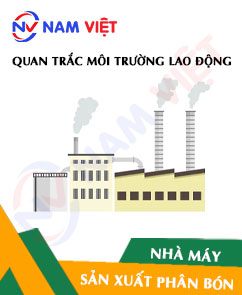
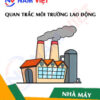
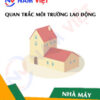




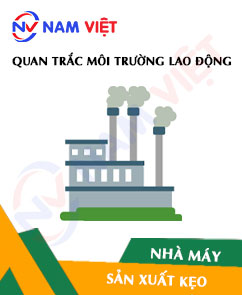

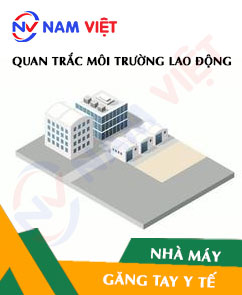

Review Occupational environment monitoring of a fertilizer manufacturing factory
There are no reviews yet.